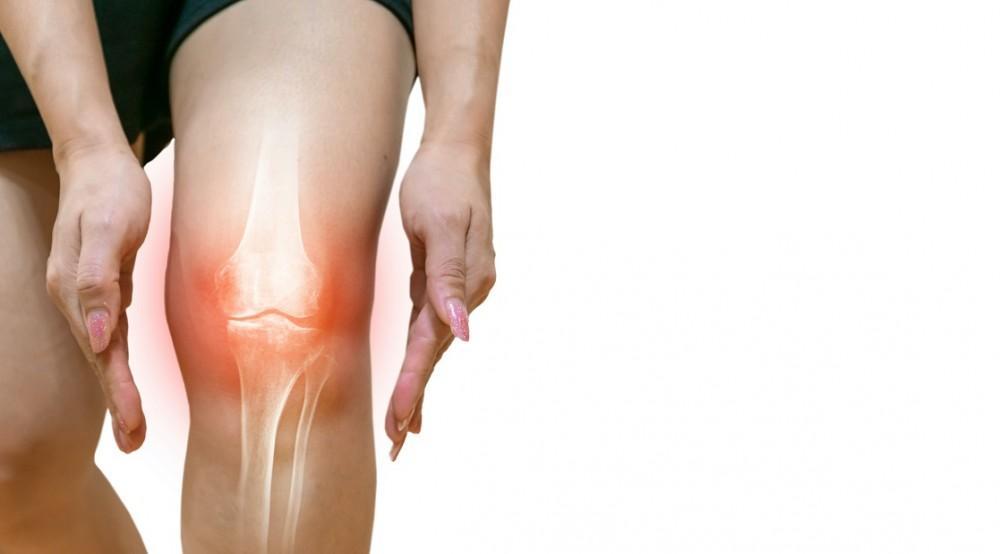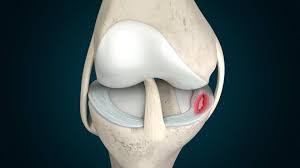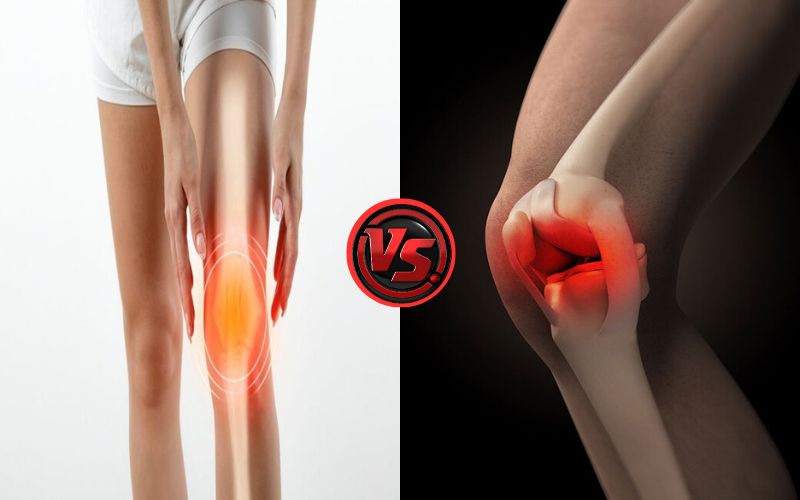9 Best Difference Between ACL and Meniscus Tear
Key Difference of ACL and Meniscus Tear
ACL and Meniscus Tear are common knee injuries that can cause pain, swelling, and reduced knee function, potentially requiring surgical intervention for severe cases. An ACL tear affects the knee’s ligament, often resulting from sudden movements or impacts, while a meniscus tear involves the knee’s cartilage, typically caused by twisting motions, with each having its own set of symptoms and treatment options.
An ACL (Anterior Cruciate Ligament) tear and meniscus tears are typical knee injuries, with distinct features. The ACL is an important ligament that supports the knee joint. It is prone to tear because of abrupt twisting or impact in activities.
The injury usually causes immediate swelling, pain, and instability, which makes it difficult to carry any weight on the leg affected. The diagnosis is based on physical examinations as well as MRI scans. Treatment options include surgery for people who are active or rehabilitation for patients who are less active.
The meniscus tear is the C-shaped cartilage of the knee, referred to as the meniscus. It is most often seen during activities that require twisting or pivoting movements. It can cause stiffness, pain, swelling, and, sometimes, experiencing catching or locking sensations.
Diagnostic evaluations include clinical examination and MRI scans. Treatment is different from traditional measures such as physical therapy and rest, to surgical intervention if needed. Knowing the main distinctions between these injuries is essential for proper treatment and healing.
what is an ACL Tear?

The ACL (Anterior Cruciate Ligament) tear is a typical and frequently debilitating knee injury that could significantly impact the person’s mobility and the quality of their life. ACL ACL is a vital ligament running diagonally throughout the joint of the knee, linking the femur (thighbone) to the tibia (shinbone).
Its primary purpose is to stabilize the knee joint, stopping the excessive forward motion of the tibia with respect to the femur, as well as instability of the rotation during sports like pivoting, jumping, and sudden changes in direction.
ACL tears usually occur when you play sports or engage in situations that involve abrupt stoppages, sudden changes of direction or direct blows at the knee. The condition is usually described by a sound when the injury occurs and is followed by swelling, pain, and instability of the knee. Patients who have an ACL tear might have difficulty putting the weight on their leg and may feel a sense that the knee is “giving way.”
The diagnosis of an ACL tear requires a thorough physical examination conducted by a medical professional. Often, this is supported by imaging tests like MRI scans to evaluate the severity and the extent to which the tear has occurred. Treatment options differ based on the person’s age, level of activity, and the severity of the injury. In some instances surgery to repair the ACL is recommended however, others might benefit from non-surgical options such as bracing and physical therapy.
Whatever treatment is chosen rehabilitation plays an essential part in restoring strength, functionality, and stability to the knee, enabling people get back up to ideal levels of exercise. An ACL tear is a serious injury that requires prompt and proper medical attention in order to improve knee health and function over the long term.
what is a Meniscus Tear?

Meniscus tears are an incredibly common knee injury that affects the meniscus. the C-shaped cartilage structure inside the joint of knees. The knee is comprised of two menisci that are located on the inside (medial) side, and one on the outside (lateral) aspect.
The wedge-shaped, rubbery pieces of cartilage function like cushions for the bone of the thigh (femur) as well as the shank bone (tibia) which provides stability and dispersing load inside the knee joint.
Meniscus tears can be because of a variety of factors including sudden pivoting or twisting movements in sports heavy lifting, and degenerative changes to the knee that are a result of the aging process. Meniscus tear typically includes swelling, pain stiffness, and occasionally an ache in your knee “catching” or “locking” when moving. Some sufferers may have difficulty in fully straightening or bending the knee.
Meniscus tears are often diagnosed by MRI scans. usually involves a physical exam by a doctor to imaging tests like MRI scans. These can provide precise information regarding the extent and location of the tear. The treatment options for meniscus tears differ according to the tear’s size and location as well as the patient’s age as well as activity level.
The small tears that occur on the outside of the meniscus could heal on their own using moderate measures such as rest, ice, and physical therapy. Contrarily larger or more complicated tears might require surgical intervention, for example, an arthroscopic procedure, which can trim or repair damaged tissue.
The aim of treatment for meniscus tears is to relieve the pain, restore joint function, as well as avoid the development of long-term issues such as osteoarthritis. Early diagnosis and proper treatment are essential to achieve the most favorable outcome for those suffering from this common knee injury.
Difference Between ACL and Meniscus Tear
Here’s a comparison chart highlighting the key differences between an ACL Tear and a Meniscus Tear:
| Aspect | ACL Tear | Meniscus Tear |
|---|---|---|
| Location of Injury | Anterior Cruciate Ligament (inside the knee joint) | Meniscus (inside the knee joint) |
| Function | Provides stability to the knee, especially against excessive forward movement and rotational instability | Acts as a cushion between the thigh bone and shin bone, distributing load and providing joint stability |
| Common Causes | Sudden twisting, pivoting, or impact during sports; direct trauma to the knee | Sudden twisting or pivoting motions, heavy lifting, degenerative changes (aging) |
| Symptoms | Immediate pain, swelling, instability, difficulty bearing weight, “popping” sound at injury | Pain, swelling, stiffness, “catching” or “locking” sensation, limited range of motion |
| Diagnosis | Physical examination, often accompanied by MRI scans | Physical examination, imaging tests (MRI), possibly joint aspiration |
| Treatment Options | Surgical reconstruction (for active individuals), physical therapy, bracing | Conservative (rest, ice, physical therapy) or surgical (arthroscopic surgery) |
| Rehabilitation | Intensive physical therapy and exercise regimen to regain strength and stability | Rehabilitation focused on restoring range of motion, strength, and joint function |
| Recovery Time | Typically longer recovery period, often 6-12 months post-surgery | Varies depending on the tear’s size and location, but generally shorter than ACL tears |
| Long-Term Consequences | Risk of knee instability, arthritis, and future injury if not treated appropriately | Risk of future knee problems, including arthritis, if not properly managed |
Symptoms of ACL Tear and Meniscus Tear
Symptoms of an ACL Tear (Anterior Cruciate Ligament):
- Immediate Pain: An ACL tear often produces sudden and intense knee pain at the time of injury.
- Swelling: Swelling of the knee joint often develops within hours after an injury has taken place and may become both noticeable and tender.
- Instability: Individuals may experience a sense of instability or “giving way” sensation in their knee during activities that involve pivoting or sudden changes of direction. This issue becomes especially noticeable during pivoting movements and sudden turns.
- Hearing/Feeling an Audible “Pop”: Many individuals report hearing or feeling an audible “pop”, snapping sensation or clicking sound immediately following ACL tears.
- Limited Range of Motion: There may be difficulty fully extending or straightening the knee.
- Bearing Weight: Walking or bearing weight on an injured leg may be painful and difficult, especially after experiencing an injury.
Symptoms of Meniscus Tear:
- Pain: Meniscus tears often cause knee pain, particularly along the joint line. This discomfort may increase when engaging in activities requiring bending or twisting the knee joint.
- Swelling: Swelling of the knee joint is a common sign following an injury and usually manifests gradually over the following day or two.
- Stiffness: Stagnant knee joints may make it more difficult to bend or straighten legs fully.
- Decreased Range of Motion: Limited range of motion is common when performing activities like squatting and kneeling, which often limit mobility.
- Clicking or Popping: Occasionally, meniscus tears can lead to audible clicking or popping sounds during knee movement, which may signal that there has been damage.
Diagnosis and Treatment
Diagnosing an ACL Tear
- Medical History: Healthcare providers will start by discussing a patient’s medical history, such as circumstances surrounding their injury, any previous knee injuries experienced, and any relevant health conditions that might exist.
- Physical Exam: Your physician will conduct a complete physical examination of your knee to detect signs of instability, tenderness, swelling, and range of motion issues.
- Lachman Test: This physical assessment evaluates ACL integrity. For this exam, a doctor applies pressure to the tibia while simultaneously stabilizing the femur; an ACL tear often leads to increased tibial translation compared to uninjured knees.
- MRI (Magnetic Resonance Imaging): Magnetic Resonance Imaging is an invaluable imaging technique for diagnosing and evaluating ACL tears, providing detailed images of ligaments that show any potential damage to them. It can also show whether any repair measures were undertaken.
Diagnosing Meniscus Tear
- Medical History: Much like an ACL tear, doctors will inquire into your past health history as well as any circumstances surrounding your knee injury.
- Physical Examination: A physical exam will be performed to detect signs of meniscus injury. Your physician may perform specific tests such as the McMurray test to detect pain or clicking associated with meniscus tears.
- MRI (Magnetic Resonance Imaging): Magnetic Resonance Imaging is considered the gold standard in diagnosing meniscus tears, providing detailed images of the menisci that reveal the location, type, and size of any tears present.
- X-rays: Although not directly visualizing the menisci, X-rays may be ordered to rule out any bone injuries or arthritis that might be present, while also helping determine a possible diagnosis.
Treatment Options for An ACL Tear
- Non-Surgical ACL Tear Repair Solutions: Whilst surgery may be the right decision for some ACL tears, particularly those less active or suffering partial tears, non-surgical methods of treating may include physical therapy to strengthen surrounding muscles, improve stability, and enhance knee functionality. An arch brace or functional brace may provide additional support during activities.
- Surgical Treatment: When it comes to severe ACL tears, significant instability, or returning to high-demand sports or activities after an ACL reconstruction surgery has failed, surgical reconstruction may be the best course of action.
- Surgery to Repair an ACL Tear: For patients undergoing ACL reconstruction surgery, typically using their own tissue or donor tissues as the graft source, extensive rehabilitation and physical therapy sessions post-surgery are crucial to ensure a full and timely recovery; typically lasting several months post-op.
- Meniscus Tear Repair: Meniscus Tear Repair, surgery alone usually does not suffice – extensive rehabilitation and physical therapy treatments must also take place post-surgery to ensure success in recovery from Meniscus Tear.
Treatment for a Meniscus Tear
- Conservative (Non-Surgical) Treatment: Small tears located near the outer rim of a meniscus with abundant blood supply may heal without surgical intervention. Non-surgical options may include rest, ice, compression, and elevation (RICE) therapy to manage pain and swelling as well as physical therapy treatment to enhance strength, flexibility, and knee function.
- Surgical Treatment: Surgery may be needed for larger or more complex meniscus tears, unstable fragments or persistent symptoms. Arthroscopic surgery is a minimally invasive option used to trim or repair torn meniscuses. Rehabilitation and physical therapy after knee surgery can be essential in restoring knee function and avoiding complications.
Prevention
Preventing ACL (Anterior Cruciate Ligament) tears and meniscus tears requires employing several strategies that aim at lowering risk during physical activities and sports, and these may include strategies like these.
Here are a few prevention tips:
Preventing ACL Tears:
- Strength and Conditioning: Engage in regular strength and conditioning exercises designed to strengthen and stabilize the muscles surrounding the knee joint, including quadriceps, hamstrings, and calf muscles.
- Balance and Proprioception Training: Incorporate balance and proprioception exercises into your fitness regime in order to increase joint stability and control.
- Proper Warm-up and Cool-down Procedures: Always warm up prior to exercise, and cool down afterward in order to prepare your muscles and joints for activity and reduce the likelihood of sudden impact to your ACL ligament.
- Technique and Form: Learn and practice proper techniques and movements for the sport or activity you choose in order to minimize awkward or dangerous movements that could cause harm, thereby decreasing the risk of injuries caused by poor form or awkward moves.
- Plyometric Training: Gradually introduce plyometric exercises into your routine in order to increase agility, jumping mechanics and landing mechanics, thereby decreasing your risk for non-contact ACL injuries.
- Supportive Bracing: Consult a healthcare provider or athletic trainer before using braces or supports on your knee, especially if there is any history of instability or injury to it.
- Footwear: Wear footwear designed specifically for your sport or activity to provide optimal support and traction.
- Field and Court Safety: For your own safety, ensure the playing surface is maintained in an ideal state to reduce risks of slipperiness or tripping hazards.
Preventing Meniscus Tears:
- Strength and Flexibility: In keeping with ACL injury prevention strategies, strong quadriceps, hamstrings and calf muscles as well as good flexibility are vital in protecting knee joint integrity and decreasing the risk of meniscus tears.
- Proper Biomechanics: Pay close attention to body mechanics and form when engaging in physical activities like squatting or lifting to minimize stress on knee joints and minimize risks of excessive damage.
- Maintain a Healthy Weight: Excess weight can significantly increase knee joint load and raise injury risks; maintaining a healthy weight through diet and exercise may offer protection.
- Avoid Overtraining: Allow for adequate rest and recovery between intense training sessions to reduce overuse injuries that could contribute to meniscus tears.
- Footwear: When engaging in activities requiring running or jumping, wear supportive and well-fitted shoes with cushioning and stability features to ensure proper cushioning and support.
- Conditioning: To maximize training and conditioning programs, ensure they cover both strength training and cardiovascular fitness in order to minimize fatigue and potential errors in form.
- Surface Evaluation: Assess your playing or exercise surface for potential hazards or irregularities that could increase the risk of tripping or falling.
Summary
An ACL (Anterior Cruciate Ligament) tear and a Meniscus Tear are two common knee injuries. An ACL tear occurs when there is damage to one or both ligaments inside of a knee joint from sports-related impacts or twisting motions and results in immediate pain, swelling, and instability within that knee. A Meniscus tear typically affects only part of one side of a meniscus tear but sometimes both can occur together leading to instability of that particular area of a joint.
Active individuals may require surgery; otherwise, rehabilitation will likely suffice. Meniscus tears affect knee cartilage by twisting or pivoting it and can lead to symptoms including pain, swelling, and joint locking or catching; these conditions range in treatment options from rest and physical therapy through rest to surgery.
ACL tears typically require lengthy rehabilitation times and can eventually lead to further knee issues; meniscus tears usually have faster recovery times but should still be properly managed to ensure an efficient healing process. Seeking professional healthcare advice is recommended in order to get tailored care that fits each person’s individual situation.


